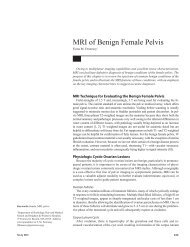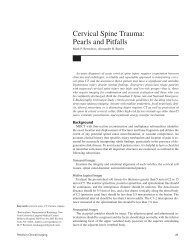Scientific Session 1 â Breast Imaging: Mammography
Scientific Session 1 â Breast Imaging: Mammography
Scientific Session 1 â Breast Imaging: Mammography
You also want an ePaper? Increase the reach of your titles
YUMPU automatically turns print PDFs into web optimized ePapers that Google loves.
Tuesday<strong>Scientific</strong> <strong>Session</strong> 12—Vascular and Interventional Radiology101. Hepatocellular Carcinoma: Response to TransarterialChemoembolization Assessed Through Semiautomated Volumetricand Functional Analysis of Diffusion-Weighted and Contrast-Enhanced MRIGowdra Halappa, V.*; Bonekamp, S.; Jolepalem, P.; Lazo, M.; Kamel, I.Russell H. Morgan Department of Radiology and Radiological Science,Johns Hopkins Hospital, Baltimore, MDAddress correspondence to V. Gowdra Halappa (vhalapp1@jhmi.edu)Objective: To retrospectively assess the diagnostic accuracy of diffusionweightedimaging (DWI) and contrast-enhanced MRI to monitor therapeuticresponses of hepatocellular carcinoma (HCC) to transcatheter arterialchemoembolization (TACE) at 1 month compared with ResponseEvaluation Criteria in Solid Tumors (RECIST) assessment at 6 months.Materials and Methods: Clinical records and MR images of 48 patientswith HCC (35 men, 13 women; mean age, 68.3 years; age range, 37–88years) with 71 different lesions were reviewed in compliance with HIPAAand with approval from our institutional review board. MR-Onco-Treat(Siemens Corporate Research) was used for inter- and intrastudy registration,tumor segmentation, volumetric measurement, and analysis ofapparent diffusion coefficient (ADC) and portal venous enhancement(VE). The predictive value of ADC and VE was then tested by a onewayanalysis of variance. Receiver operator characteristics curves (AUC)were generated to determine the diagnostic accuracy of ADC and VE.Results: Classification according to RECIST at 6 months staged 30 lesionsas partial response (PR), 30 lesions as stable disease (SD), and 6 lesions asprogressive disease (PD). The percentage increase in ADC (p = 0.0001),percentage of stable ADC (p = 0.004), percentage decrease in VE (p =0.002), and percentage of stable VE (p = 0.008) were found to be statisticallysignificant predictors of tumor response according to RECIST (p =0.0001, 0.004, 0.002, and 0.008, respectively). The cutoffs for PR versusSD + PD were 51.3% increase in ADC (AUC = 0.78) and 51.9% decreasein VE (AUC = 0.73). For PR + SD versus PD, the cutoffs were 29.6%inerease in ADC (AUC = 0.89 and 26.8% decrease in VE (AUC = 0.90).Conclusion: Increase in ADC and decrease in VE 1 month post-TACEare reliable and accurate predictors of change in tumor size at 6 months.Given the ease of measurement and the inherent value of having thisinformation earlier in a treatment course, new criteria using ADC and VEshould be established to evaluate response to TACE in HCC.102. Implementing an Informatics-Enabled Process for BiopsyResult Follow-Up in Interventional RadiologyAlkasab, T.*; Harris, M.; Gervais, D.; Thrall, J. Massachusetts GeneralHospital, Boston, MAAddress correspondence to T. Alkasab (talkasab@partners.org)Objective: Our abdominal interventional radiology service performsdozens of percutaneous biopsies each week. This volume combined withthe cumbersome nature of poring through the electronic medical record(EMR) has meant that radiologists do not routinely review pathology resultsfrom their biopsies. We have attempted to bring breast radiology’srigorous process of biopsy follow-up and evaluation for concordancewith imaging to abdominal interventional radiology.Materials and Methods: We created an informatics tool to systemicallysearch for pathology results from percutaneous biopsies. A weekly searchis run against the department’s radiology information system for examinationscoded as abdominal percutaneous biopsies. The system thenperforms a query against our institution’s EMR for new pathology andcytology reports associated with these biopsies. Each case where resultsare available is manually reviewed, and categorized as “positively malignant,”“not positively malignant,” or “non-focal.” At a weekly dedicatedconference, the group of abdominal radiologists reviews the preprocedurediagnostic imaging and the images of the procedure itself for each“not positively malignant” case. The group arrives at a consensus: eitherthe benign/negative result is likely to be a true result or the biopsied lesionrequires further workup. When the consensus is that there may be adiscrepancy, the radiologists who performed the procedure are assignedto contact the referring physicians and advise them regarding strategiesfor repeat biopsy or follow-up imaging.Results: This system has been in place for 11 weeks. In that time, pathologyresults for 262 percutaneous biopsies were captured, a rate ofapproximately 24 per week. Fifty-six results were deemed to be “notpositively malignant” and reviewed in conference. Of these, 10 resultedin a consensus that further workup was required and that the referringphysician should be contacted.Conclusion: We have demonstrated the feasibility of implementing a processof systemic review of percutaneous biopsy results in a busy abdominalinterventional radiology section. Information technology to integrateradiology and pathology data is crucial for lowering the clerical burden.This process improves the care we provide our patients by ensuring thatreferrers are aware of the potential significance of discordant results. Wehave also improved service to our referring colleagues by proactivelycontacting them to discuss options for further management.103. Evaluation of Abdominal Aortic Maximum Diameter:Normative Data to Guide Screening Patients for Abdominal AorticAneurysmsKothari, K. 1 *; Siegel, E. 2,3 1. Baylor College of Medicine, Houston,TX; 2. Baltimore VA Medical Center, Baltimore, MD; 3. University ofMaryland School of Medicine, Baltimore, MDAddress correspondence to K. Kothari (kdkothar@bcm.edu)Objective: Abdominal aortic aneurysms (AAA) are diagnosed in 2–4% ofadults and are frequently found incidentally on CT scans. Traditionally,radiologists comment on the maximum aortic diameter on abdominalCT examinations, including recommendations for yearly follow-up inpatients who have an aortic diameter greater than 3 cm irrespective ofage. To our knowledge, there are not extensive normative data describingaverage maximum abdominal aortic diameter and correlation with ageand gender, nor are there published data on the aortic area as a guidelinefor radiologists. The goal of this study was to provide normative data onaverage maximum long axis, short axis, and areas of abdominal aortas.Materials and Methods: One hundred patients (not restricted to smokers)who had abdominal thin-slice CT studies with or without contrast enhancementin 2010 at the Maryland VA Healthcare System were chosen randomlyfor analysis. The studies were obtained using 0.75-mm collimation with re-*Will present paperA39
















